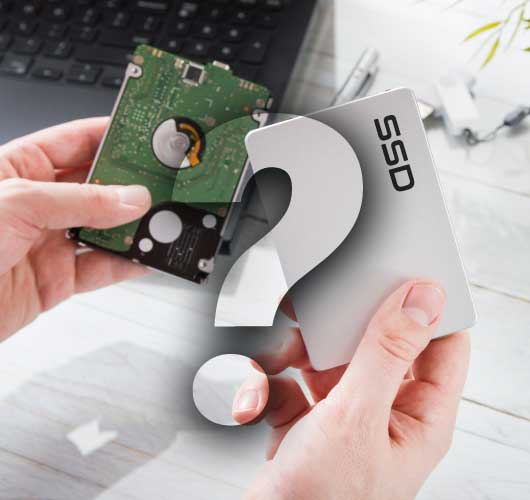Frequently Asked Questions
31st Jan 2021

What is SSD?
An SSD (solid-state drive) is a type of nonvolatile storage media that stores persistent data on solid-state flash memory. Two key components make up an SSD: a flash controller and NAND flash memory chips. The architectural configuration of the SSD controller is optimized to deliver high read and write performance for both sequential and random data requests. SSDs are sometimes referred to as flash drives or solid-state disks.[1]
What is the difference between SSD and HDD?
A hard disk drive (HDD) is an old-school storage device that uses mechanical platters and a moving read/write head to access data. A solid-state drive (SSD) is a newer, faster type of device that stores data on instantly-accessible memory chips. Fundamentally, their purpose is the same: These storage devices preserve your memories, music, documents, and programs. But the technology behind them couldn’t be more different:
- HDDs: An enclosure contains a series of platters covered by a ferromagnetic coating. The direction of the magnetization represents the individual bits. Data is read and written by a head (similar to the way vinyl record albums work) that moves extremely fast from one area of the disk to another. Since all of these pieces are “mechanical,” the hard disk is the slowest component of any computer – and the most fragile.
- SSD: These newer types of disks store information on flash memory, which consists of individual memory cells storing bits that are instantly accessible by the controller.
The speed difference is significant. SSDs are extremely fast in all areas, but the speed difference is more pronounced when performing certain tasks, such as:
- Sequential read/write operations: Copying and moving huge files (such as movies) is where the difference is most apparent. On old-school HDDs, the copying process takes 30-150 MB per second (MB/s), where the same action takes about 500 MB/s on normal SSD, or even 3,000-3,500 MB/s on new NVME SSDs. In this example, copying a 20 GB movie is complete in less than 10 seconds with an SSD, while a hard disk would need at least two minutes.
- Small “4K” read/write operations: Most of the time, when you run Windows (or MacOS), open programs, or browse the web, you’re actually opening and manipulating thousands of smaller files, which are stored in small blocks of data (usually sized at 4K). The faster your disk can read (and write) these 4K blocks, the faster and snappier your system seems. With HDDs, the speed ranges from 0.1 to 1.7 megabytes per second (MB/s). SSDs and NVME SSDs, however, operate at much faster speeds of 50-250 MB/s in 4K reads/writes.
If you are concerned about how much information you can store on each type of drive, be reassured. There are no differences in storage capacity. You can get HDDs and SSDs in similar sizes.[2]
What is the difference between SSD & RAM?
SSDs use a special type of memory circuitry called non-volatile RAM (NVRAM) to store data, so everything stays in place even when the computer is turned off.
Even though SSDs use memory chips instead of a mechanical platter that has to be read sequentially, they’re still slower than the computer’s RAM.[3]
How much DDR4 is faster than DDR3?
DDR3 RAM is the 3rd iteration of what is now known as SDRAM (Synchronous Dynamic Random Access Memory) and was previously thought of as the go-to RAM when choosing memory. However, since the announcement of DDR4 in 2014, we’ve seen a rapid reduction in DDR3 sales across the board.Like most new technology, DDR4 RAM comes equipped with a bunch of cool new features and advancements over its predecessor. It offers much faster speeds, more capacity, and (overall) better build quality.
The first and most obvious difference between DDR3 and DDR4 RAM is found within the pin nodules. DDR3, when introduced back in 2007, came to the table with a 240 pin nodule which was designed for older generation motherboards. However, when DDR4 arrived (7 years later), it no longer made use of the same 240 pin nodule. Developers opted for a larger pin nodule of 288 which can clearly be seen when comparing the two, visually.Clock speed is measured in MHz and references how fast your RAM can read and write that data when in communication with the CPU. So, as a general rule of thumb, faster RAM is usually better when using high-demanding RAM applications like Photoshop.DDR3 RAM has a maximum speed of 2133mhz. On the flipside, DDR4 starts at 2133mhz and has a maximum of 4800mhz meaning it has a much faster transfer rate.[4]You might wonder how the different RAM generations affect performance. For the average user, it really won't make much of a difference. DDR4 is theoretically faster than DDR3, but it's not often that RAM speed is the bottleneck on your system. [5]
References
[1] Margaret Rousehttps://searchstorage.techtarget.com/definition/SSD-solid-state-drive
[2] Sandro Villingerhttps://www.avast.com/c-ssd-vs-hdd#topic-7
[3] Roderick Bauerhttps://www.backblaze.com/blog/whats-diff-ram-vs-storage/#:~:text=SSDs%20use%20a%20special%20type,slower%20than%20the%20computer's%20RAM.[4] Charlie Noonhttps://www.wepc.com/reviews/ddr3-vs-ddr4/
[5] BEN STEGNERhttps://www.makeuseof.com/tag/difference-ddr2-ddr3-ram-technology-explained/





